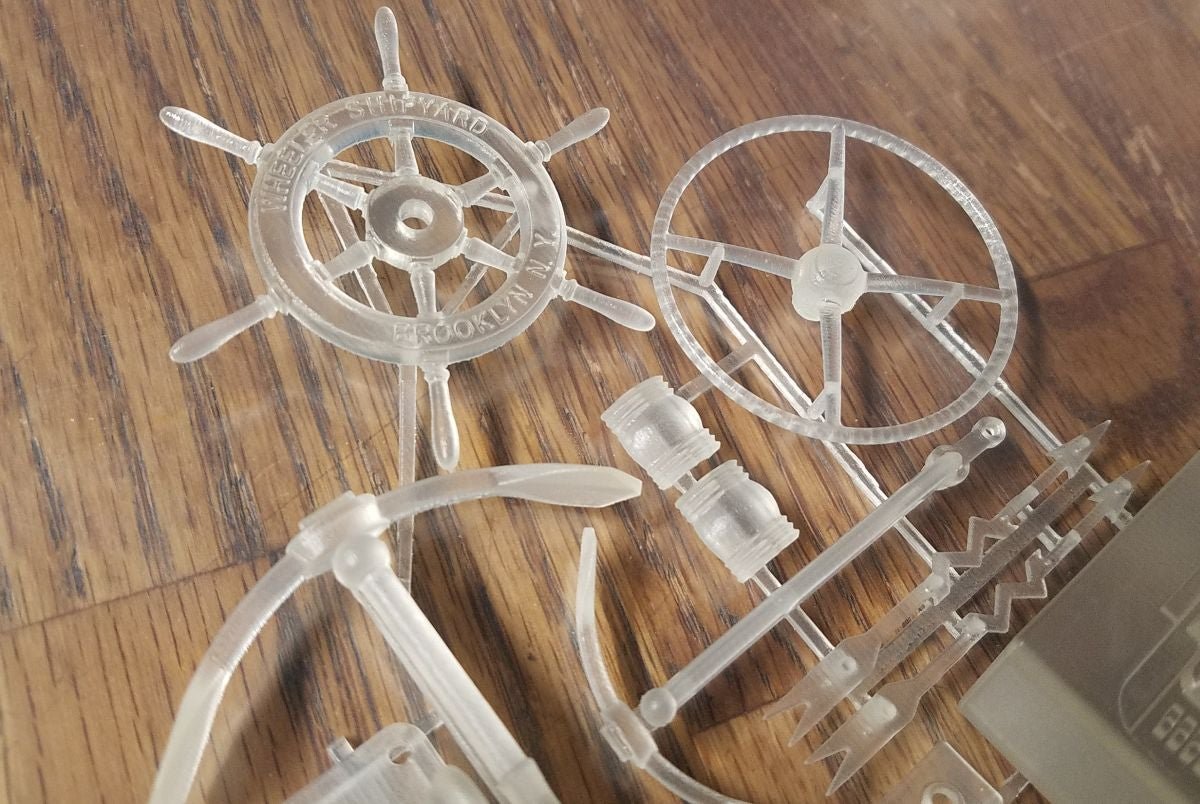-
Posts
1,183 -
Joined
-
Last visited
Content Type
Profiles
Forums
Gallery
Events
Everything posted by CPDDET
-
Welcome aboard!
-

3D printing material question
CPDDET replied to CPDDET's topic in CAD and 3D Modelling/Drafting Plans with Software
Thanks for that input! -

3D printing material question
CPDDET replied to CPDDET's topic in CAD and 3D Modelling/Drafting Plans with Software
Can this material be milled? I have some parts with voids that need to be filled in order to avoid thin walls, then milled to create some of the voids. So the material would have to meet that requirement as well. Example: the foredeck winch has a round protruding tube where the winch handle would be inserted. The walls of the tube are too thin to be printed. But if I have that void filled it could be printed. I can then mount the winch on my mill and drill out that void creating the needed tube for detail. I understand a high detail resin produces a rigid, opaque product? Learning a lot here! -

3D printing material question
CPDDET replied to CPDDET's topic in CAD and 3D Modelling/Drafting Plans with Software
Company is: Advanced Additive Innovations didn't see a default option. You may have to upload a file to see material options. Thanks! -
Being new to 3D printing I'm a bit lost when it comes to choosing the proper material. I'm about to submit a file to a 3D printing company but they all require choosing a material, of which there are dozens. The parts I'm printing are quite small. L-.489 W-.811 H-.378. But detail is important, more so than fragility. Also the parts will be painted. Any input or advice is appreciated. Dave
-
Welcome aboard!
-
Welcome aboard!
-

CAD file 3D printing question
CPDDET replied to CPDDET's topic in CAD and 3D Modelling/Drafting Plans with Software
We will see. Right now things are going quite well with Ed, the owner of CIDEAS Inc in Crystal Lake IL which is only 30 minutes from my home. So far he is suggesting Accura Xtreme White 200 resin in a SLA process. I think many of the parts can be modified to eliminate the issue of walls being too thin. I don't think adding 1 mm (.0394) will make the part look out of scale. Most hollows can be filled. Parts like the side lamp body and side lamp lens could be combined in CAD and then printed as one piece. So there are some workarounds. Not sure yet what the charge will be to modify the current files. If its over the top Ill be getting back to you. If needed, I will gladly reimburse you for your time. -

Pin vise recommendations
CPDDET replied to kgstakes's topic in Modeling tools and Workshop Equipment
I often use McMaster Carr. Also jeweler supply companies. -

CAD file 3D printing question
CPDDET replied to CPDDET's topic in CAD and 3D Modelling/Drafting Plans with Software
I've attempted to use CraftCloud, as well as a few others but all say the wall thickness is too thin. None of these companies offered help in finding a solution. While they offer 3D printing, they don't offer help in modifying the files, something I can't do. I'm now working with a local company who is willing to work with me. I'll keep you posted. -

Pin vise recommendations
CPDDET replied to kgstakes's topic in Modeling tools and Workshop Equipment
I purchased a 3 piece set from Starrett years ago and never looked back. Expensive? Yes. But a quality too that will last a lifetime. -

CAD file 3D printing question
CPDDET replied to CPDDET's topic in CAD and 3D Modelling/Drafting Plans with Software
Decided to scale down from 1/12 to 1/18. Still searching for someone to do the printing. I would probably get more from the answers posted if I understood the jargon. But I'm completely ignorant when it comes to CAD CAM. -
Beautiful work! And welcome aboard.
-

CAD file 3D printing question
CPDDET replied to CPDDET's topic in CAD and 3D Modelling/Drafting Plans with Software
Yes, Pat's scratch build. Can I use the STL's you sent me? I plan on my build being at a smaller scale. In your opinion, how much smaller of a scale is possible to get these parts made? Pats model is 1:12 scale. -
Can anyone provide a reliable source for 3D printing?
-

CAD file 3D printing question
CPDDET replied to CPDDET's topic in CAD and 3D Modelling/Drafting Plans with Software
Was able to unzip and open files in FreeCad program. Will follow up later with a few more questions. -

CAD file 3D printing question
CPDDET replied to CPDDET's topic in CAD and 3D Modelling/Drafting Plans with Software
Pilar v291.step -

CAD file 3D printing question
CPDDET replied to CPDDET's topic in CAD and 3D Modelling/Drafting Plans with Software
OK, looks like I'm going to take a step back and ask for some help. First off I don't have a way to open the STEP file to see what's in it. At this point I'm assuming that the file is actually for the parts pictured in my original post. So lets start there. Can anyone suggest a program (hopefully a free one) that will allow me to open the file or is anyone willing to open the file for me to see exactly what's in it? I could email the file to anyone who would be willing do this. Dave -
This subject is way out of my sandbox but hoping I can gain some insight. I have a CAD file for some ships parts. This file was created by someone else but they have made it available for anyone online. The file is for 3d printing of several parts of Hemingways fishing boat, Pilar. However his build was for 1/12 scale pieces and my build will be either 1/24 or 1/27. Can the person, or company, 3d printing these resize them if I tell them the scale or percent size needed? Is there a source that can be recommended for the actual 3d printing service? Here in image of the pieces I need to have printed. Any help is much appreciated.
-
Welcome aboard!
-

Staining of hulls.
CPDDET replied to serpe's topic in Painting, finishing and weathering products and techniques
I used a satin wipe on poly for the deck of my bluenose and was very pleased with the outcome.
About us
Modelshipworld - Advancing Ship Modeling through Research
SSL Secured
Your security is important for us so this Website is SSL-Secured
NRG Mailing Address
Nautical Research Guild
237 South Lincoln Street
Westmont IL, 60559-1917
Model Ship World ® and the MSW logo are Registered Trademarks, and belong to the Nautical Research Guild (United States Patent and Trademark Office: No. 6,929,264 & No. 6,929,274, registered Dec. 20, 2022)
Helpful Links
About the NRG
If you enjoy building ship models that are historically accurate as well as beautiful, then The Nautical Research Guild (NRG) is just right for you.
The Guild is a non-profit educational organization whose mission is to “Advance Ship Modeling Through Research”. We provide support to our members in their efforts to raise the quality of their model ships.
The Nautical Research Guild has published our world-renowned quarterly magazine, The Nautical Research Journal, since 1955. The pages of the Journal are full of articles by accomplished ship modelers who show you how they create those exquisite details on their models, and by maritime historians who show you the correct details to build. The Journal is available in both print and digital editions. Go to the NRG web site (www.thenrg.org) to download a complimentary digital copy of the Journal. The NRG also publishes plan sets, books and compilations of back issues of the Journal and the former Ships in Scale and Model Ship Builder magazines.




